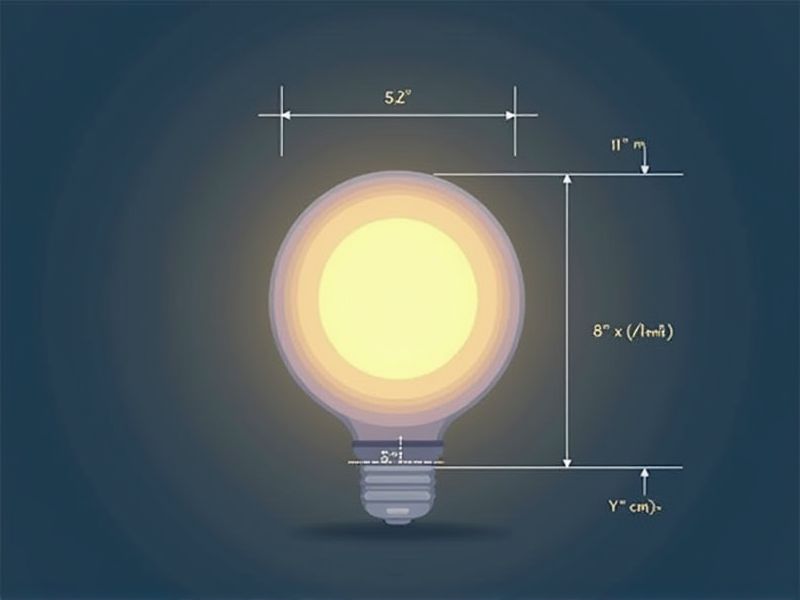
When choosing an LED light, understanding standard dimensions can help ensure it fits your fixture or space. For example, common household LED bulbs often follow the A19 standard, which measures approximately 2.4 inches in diameter and 4.3 inches in height. Panel LEDs might come in sizes like 1x4 ft, 2x2 ft, or 2x4 ft, suitable for ceilings and office lighting. Always check product specifications for exact measurements, as dimensions can vary depending on design and intended use.
Bulb Base Size
The standard bulb base sizes for LED lights include popular options like E26 (26 mm diameter) and E27 (27 mm diameter), commonly used in residential settings. These sizes ensure compatibility with a wide range of fixtures, facilitating easy replacements and upgrades. In commercial applications, GU10 (10 mm pin spacing) and MR16 bases are favored for their versatility and energy efficiency. Understanding these specifications can significantly enhance your lighting choices while optimizing energy consumption and illumination quality.
Led Bulb Diameter
The diameter of LED bulbs is a crucial specification, typically measured in millimeters, impacting both performance and compatibility. Common LED bulb diameters include 5mm, 10mm, and 20mm, with larger diameters providing broader light distribution. Choosing the appropriate bulb diameter can enhance fixture fitting, energy efficiency, and overall lighting quality. For optimal results, consider your specific lighting needs and ensure your chosen LED bulb aligns with the standard diameter suitable for your fixtures.
Bulb Length
LED bulb length typically ranges from 2 to 6 inches, affecting both aesthetic and functional aspects of lighting. A longer bulb can produce a more extensive light spread, making it suitable for larger spaces, while shorter bulbs often excel in directional lighting applications. The output of light is measured in lumens, with many LED bulbs offering 800 to 1600 lumens, depending on length and design. When selecting an LED bulb, consider not just the length but also its compatibility with fixtures and the desired brightness for your environment.
Led Panel Thickness
The thickness of LED panels significantly impacts their efficiency and installation versatility, typically ranging from 4 to 10 millimeters for most commercial options. Thinner panels, around 4 to 6 millimeters, offer a sleek aesthetic and are ideal for mounting in tight spaces, while thicker options provide enhanced durability. A standard 600x600 millimeter LED panel with a 10-millimeter thickness can emit over 4000 lumens, ensuring optimal brightness output. When selecting LED panels, consider how the thickness aligns with your lighting needs and aesthetic preferences.
Tube Light Length
LED tube lights typically come in standard lengths of 2 feet (60 cm) and 4 feet (120 cm), catering to various lighting needs. Choosing the appropriate length is essential for achieving optimal illumination in spaces such as offices, garages, or homes. Most LED tube lights have a power consumption of around 15 to 20 watts, offering energy-efficient alternatives to traditional fluorescent tubes. Your choice of LED tube length can significantly impact both aesthetic appeal and energy savings in your environment.
Led Strip Width
When selecting LED strips, the width is crucial, usually ranging from 8mm to 12mm for optimal performance. A wider strip often accommodates more LEDs, which can result in higher lumens per meter, enhancing brightness levels significantly. For example, a standard 16.4-foot (5-meter) strip typically has around 60 to 120 LEDs, effectively illuminating spaces while maintaining energy efficiency. Selecting the appropriate width ensures your lighting solution meets both aesthetic and functional requirements, tailored to your specific lighting projects.
Beam Angle
The beam angle of an LED light significantly influences its illumination quality, typically ranging from 15 to 120 degrees. A narrower beam angle, such as 15 to 30 degrees, provides concentrated light, ideal for spot lighting or accentuating specific areas. In contrast, a wider beam angle, like 60 to 120 degrees, offers broader coverage, suitable for ambient lighting in larger spaces. When selecting LED lights, consider your specific lighting needs and the desired effect to maximize efficiency and aesthetics.
Bulb Shape
LED bulb shapes are crucial for ensuring proper light distribution and aesthetic appeal. The A19 shape is the most common, measuring 2.375 inches in diameter and 4.33 inches in height, making it ideal for standard residential fixtures. For decorative purposes, the C7 and C9 shapes serve well in holiday and accent lighting, providing vibrant colors and unique designs. Understanding these shapes can help you select the perfect LED bulb for various applications, enhancing your lighting experience.
Fixture Compatibility
When selecting LED lights, fixture compatibility is crucial for optimal performance and efficiency. Ensure that the wattage and dimensions of the LED bulb match the specifications of your existing fixtures, as this can prevent overheating and enhance lifespan. Pay attention to the lumens output, which typically ranges from 800 to 1600 lumens for general lighting, allowing you to achieve the desired brightness without compromising energy efficiency. With fixtures designed for LED technology, you can expect a substantial reduction in energy consumption, often around 75% compared to traditional incandescent bulbs.
Heat Sink Size
The effectiveness of LED lights significantly depends on the heat sink size, which plays a crucial role in thermal management. A larger heat sink typically allows for improved heat dissipation, maintaining optimal operating temperatures while ensuring the longevity of the LED lifespan, which can exceed 50,000 hours. For instance, a heat sink designed for a 10W LED may measure around 10 cm2 to 15 cm2, while one for a 100W LED could extend beyond 100 cm2. By prioritizing an adequately sized heat sink, you enhance both the efficiency and performance of your LED lighting system.
